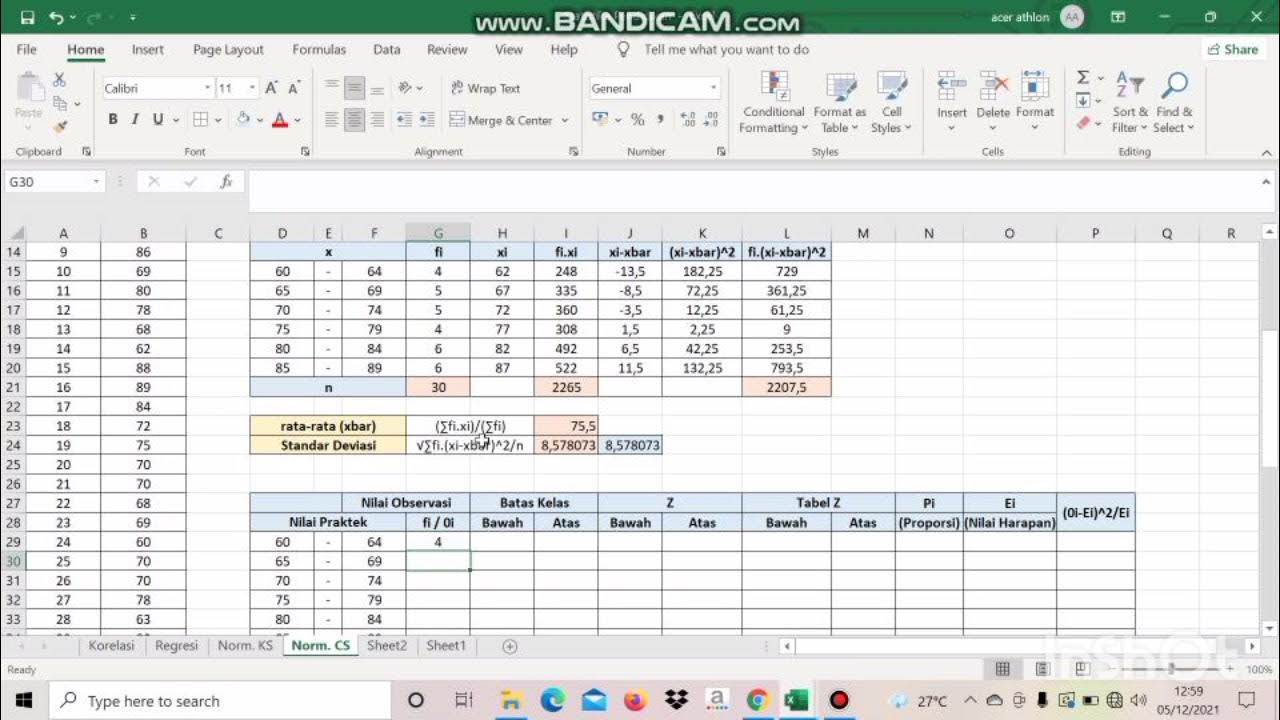Normality test [Simply Explained]
Summary
TLDRIn this video, the importance of testing data for normal distribution is explained. Normal distribution is crucial for hypothesis testing, such as t-tests and ANOVAs. The video covers both analytical and graphical methods for checking normality, including tests like the Shapiro-Wilk and Anderson-Darling tests. It highlights the challenge of sample size influencing p-values and the advantages of graphical methods like histograms and QQ plots for visualizing normality. The video concludes with a practical demonstration of how to test data for normal distribution using statistical software and choosing the right tests based on the results.
Takeaways
- 😀 Normal distribution is crucial for hypothesis testing, such as t-tests or ANOVA.
- 😀 Data is considered normally distributed if its frequency distribution resembles a bell curve.
- 😀 To test for normal distribution, you can use either analytical or graphical methods.
- 😀 Analytical tests include the Kolmogorov-Smirnov test, Shapiro-Wilk test, and Anderson-Darling test.
- 😀 In analytical testing, the null hypothesis assumes that the data follows a normal distribution.
- 😀 If the p-value from a test is less than 0.05, the data is considered not normally distributed.
- 😀 A p-value greater than 0.05 suggests that normal distribution cannot be disproven, but it’s not a confirmation.
- 😀 Sample size can influence p-values; small samples may show larger p-values, while large samples may produce smaller p-values.
- 😀 Graphical methods for testing normal distribution include histograms and QQ plots (quantile-quantile plots).
- 😀 In a QQ plot, if data points lie on the line, the data is normally distributed; deviations suggest otherwise.
- 😀 It is important to consider normal distribution checks when conducting hypothesis tests to ensure valid results.
Q & A
Why is it important to test for normal distribution in data analysis?
-Testing for normal distribution is crucial because many statistical tests, like t-tests or ANOVA, assume that the data follow a normal distribution. If this assumption is violated, the results of the hypothesis tests may not be valid.
What does it mean if data is normally distributed?
-Data is normally distributed if its frequency distribution forms a bell curve, with most of the data points clustering around the mean, and the distribution being symmetrical.
How can you test if your data is normally distributed?
-There are two main ways to test for normal distribution: analytically (using statistical tests like the Kolmogorov-Smirnov test, Shapiro-Wilk test, or Anderson-Darling test) and graphically (using histograms or QQ plots).
What is the role of the p-value in normality tests?
-The p-value indicates whether the data is normally distributed. If the p-value is less than 0.05, it suggests that the data significantly deviates from normal distribution. If it is greater than 0.05, the data cannot be disproven as normal, but it doesn't confirm normality either.
What happens if the p-value is smaller than 0.05?
-A p-value smaller than 0.05 indicates a significant deviation from normality, meaning the data does not follow a normal distribution.
What should you do if the p-value is greater than 0.05?
-If the p-value is greater than 0.05, you cannot reject the null hypothesis, which means you assume the data is normally distributed. However, it’s not a definitive confirmation.
Why do analytical tests for normal distribution depend on sample size?
-The p-value from normality tests can be influenced by sample size. With a small sample, the p-value may be large, leading to a false assumption of normality. With a large sample, even slight deviations from normality may result in a small p-value, suggesting non-normality.
What are the drawbacks of using analytical methods to test for normal distribution?
-The primary drawback is that p-values are affected by sample size. Small samples may not show deviations from normality, while large samples may detect trivial deviations, leading to misleading conclusions about normality.
What is a QQ plot and how is it used to assess normality?
-A QQ plot compares the quantiles of your data to the quantiles of a normal distribution. If the points closely follow a straight line, the data is likely normally distributed. Deviations from the line indicate non-normality.
What can you infer if most data points in a QQ plot lie within the 95% confidence interval?
-If most of the data points lie within the 95% confidence interval in a QQ plot, it suggests that the data is likely normally distributed. Large deviations from the line or confidence interval indicate non-normality.
What alternative test should you use if your data is not normally distributed?
-If your data is not normally distributed, you can use non-parametric tests, such as the Mann-Whitney U test, which do not require normality assumptions.
How can you check normality using software like DataTab?
-To check normality in DataTab, you can copy your data into the table, select descriptive statistics, choose the variable you want to test, and then click on the 'test for normal distribution' option. The software will display the results, including the p-value and graphical tests.
Outlines

Этот раздел доступен только подписчикам платных тарифов. Пожалуйста, перейдите на платный тариф для доступа.
Перейти на платный тарифMindmap

Этот раздел доступен только подписчикам платных тарифов. Пожалуйста, перейдите на платный тариф для доступа.
Перейти на платный тарифKeywords

Этот раздел доступен только подписчикам платных тарифов. Пожалуйста, перейдите на платный тариф для доступа.
Перейти на платный тарифHighlights

Этот раздел доступен только подписчикам платных тарифов. Пожалуйста, перейдите на платный тариф для доступа.
Перейти на платный тарифTranscripts

Этот раздел доступен только подписчикам платных тарифов. Пожалуйста, перейдите на платный тариф для доступа.
Перейти на платный тарифПосмотреть больше похожих видео

Uji Normalitas Lilliefors | cara cepat uji normalitas lilliefors di Excel | Uji normalitas excel

UJI NORMALITAS: Kenapa & Variabel apa yang dapat Diuji Normalitas-nya?

27. Normality Testing of the Data in IBM SPSS || Dr. Dhaval Maheta

Uji Perbandingan One Sample t Test

#4 Uji Normalitas Chi Square dengan Excel - Statistika Pendidikan

The Central Limit Theorem, Clearly Explained!!!
5.0 / 5 (0 votes)
